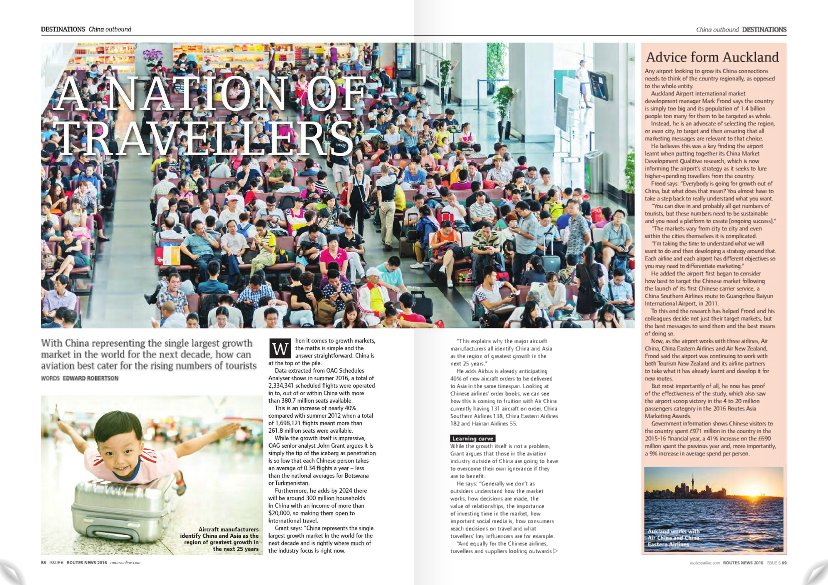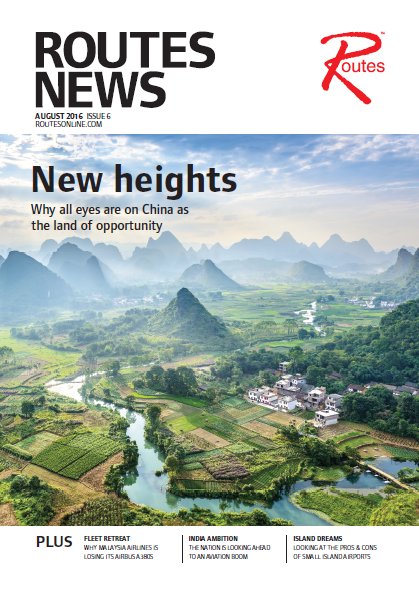When it comes to growth markets, the maths is simple and the answer straightforward. China is at the top of the pile. Data extracted from the OAG Schedules Analyser shows in summer 2016, a total of 2,334,341 scheduled flights were operated in to, out of or within China with more than 380.7 million seats available.
This is an increase of nearly 40% compared with summer 2012 when a total of 1,698,121 flights meant more than 261.8 million seats were available. While the growth itself is impressive, OAG senior analyst John Grant argues it is simply the tip of the iceberg as penetration is so low that each Chinese person takes an average of 0.34 flights a year – less than the national averages for Botswana or Turkmenistan.
Furthermore, he adds by 2024 there will be around 300 million households in China with an income of more than $20,000, so making them open to international travel. Grant says: “China represents the single largest growth market in the world for the next decade and is rightly where much of the industry focus is right now. This explains why the major aircraft manufacturers all identify China and Asia as the region of greatest growth in the next 25 years.”
He adds Airbus is already anticipating 40% of new aircraft orders to be delivered to Asia in the same timespan. Looking at Chinese airlines’ order books, we can see how this is coming to fruition with Air China currently having 131 aircraft on order, China Southern Airlines 138, China Eastern Airlines 182 and Hainan Airlines 55.
While the growth itself is not a problem, Grant argues that those in the aviation industry outside of China are going to have to overcome their own ignorance if they are to benefit. He says: “Generally we don’t as outsiders understand how the market works, how decisions are made, the value of relationships, the importance of investing time in the market, how important social media is, how consumers reach decisions on travel and what travellers’ key influencers are for example. And equally for the Chinese airlines, travellers and suppliers looking outwards they have the same challenges in understanding us.”
Dr Zheng Lei, the director at Surrey Univeristy’s centre for aviation research, agrees that the market is one to watch, particularly as his own knowledge of how they behave in the UK is likely mirrored elsewhere.
He says Chinese travellers tend to stay in the UK for more than seven days and are keen to visit places like Scotland and Manchester as well as London. Lei believes this, coupled with a keen appreciation of cost, means many of the UK’s secondary airports could find themselves in prime position for new routes catering for Chinese tourists.
Direct flights are a must, he adds and airports should consider negotiating with China’s regional governments, many of which recognise the importance of route development and have money to invest accordingly. But even before airports enter oversees negotiations, Lei says there are three basic steps they can take in preparation for a successful outcome.
Airport signs should be in Chinese to aid travellers while a few Chinese-speaking staff are seen as vital. Airports should also introduce their own Chinese-language apps which they can use to share important information from flight delays to gate changes with Chinese travellers.
The apps must also be available via free Wi-Fi, although this is not simply to ensure Chinese travellers are kept well informed. Lei says: “Chinese tourists like shopping and they are not only shopping for themselves; most Chinese tourists have got a long shopping list for their friends. When they are in a shop they normally take a picture and send it to them to see if they like it so they can buy it.”
Like Grant, Lei believes that airports outside China can also be a source of knowledge for Chinese airlines, which are keen to tap into western and other markets but are equally unsure as to how best to do this.
He says: “Chinese airlines find it difficult to penetrate into European markets, for example with all the flights in China you will see the majority are Chinese passengers, usually about 70% or 80%. They are not clear how to target the European passengers or the British passengers and those relevant airports can help those airlines to understand them.”
As well as ensuring the airports are ticking all the right boxes, Patricia Yates, strategy and communications director for UK tourism board VisitBritain, adds those promoting the airport’s destination also have work to do.
“You need two things,” she says. “Aspiration to travel, and we know the Chinese rate Britain highly for culture, plus you have to offer the means to get people here easily and that’s particularly important in China. If you haven’t got enough capacity it makes the seats more expensive and it becomes a barrier to travel for the market.”
She agrees the Chinese market is one worth fighting for and especially from VisitBritain’s point of view, as it has identified the family market as one worth focusing on as they stay 10 nights on average and tend to travel around more. They also spend quite a bit – an average of £2,174 (per person) in 2015.
Yates says work so far has seen Chinese visitor number more than triple from the 89,000 who visited the UK in 2009 to 270,000 in 2015. However, with a target of doubling the value of the Chinese market by 2020, she admits there is still much to do. “This isn’t about laying down plans for the future, it is about developing them now,” she says. “We need to be in there and competing now.”
Any airport looking to grow its China connections needs to think of the country regionally, as opposed to the whole entity, according to Auckland International Airport. Its international market development manager Mark Frood says the country is simply too big and its population of 1.4 billion people too many for them to be targeted as whole. Instead, he is an advocate of selecting the region, or even city, to target and then ensuring that all marketing messages are relevant to that choice.
He believes this was a key finding the airport learnt when putting together its China Market Development Qualitive research, which is now informing the airport’s strategy as it seeks to lure higher-spending travellers from the country.
Frood says: “Everybody is going for growth out of China, but what does that mean? You almost have to take a step back to really understand what you want. You can dive in and probably all get numbers of tourists, but these numbers need to be sustainable and you need a platform to create [ongoing success].”
“The markets vary from city to city and even within the cities themselves it is complicated. I’m taking the time to understand what we will want to do and then developing a strategy around that. Each airline and each airport has different objectives so you may need to differentiate marketing,” he adds.
He added the airport first began to consider how best to target the Chinese market following the launch of its first Chinese carrier service, a China Southern Airlines route to Guangzhou Baiyun International Airport, in 2011. To this end the research has helped Frood and his colleagues decide not just their target markets, but the best messages to send them and the best means of doing so.
Now, as the airport works with three airlines, Air China, China Eastern Airlines and Air New Zealand, Frood said the airport was continuing to work with both Tourism New Zealand and its airline partners to take what it has already learnt and develop it for new routes.
But most importantly of all, he now has proof of the effectiveness of the study, which also saw the airport scoop victory in the 4 to 20 million passengers category in the 2016 Routes Asia Marketing Awards. Government information shows Chinese visitors to the country spent £971 million in the country in the 2015-16 financial year, a 41% increase on the £690 million spent the previous year and, more importantly, a 9% increase in average spend per person.
 |
This article is modified from an original feature that appeared in... ROUTES NEWS - ISSUE 6, 2016 PLEASE CLICK HERE to view the magazine. |
 |





